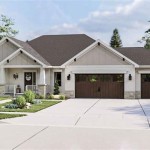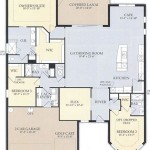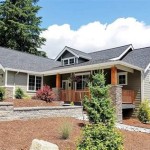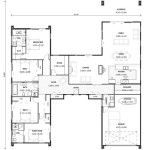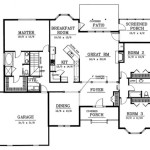Single Family Home Building Plans: A Comprehensive Guide
Single family home building plans serve as the architectural blueprint for constructing a detached residential dwelling intended for occupancy by a single family. These plans are far more than just drawings; they are comprehensive documents encompassing structural, mechanical, electrical, and plumbing (MEP) systems, aesthetic considerations, and adherence to local building codes and regulations. The process of developing robust and accurate building plans is critical to the success, cost-effectiveness, and long-term safety of any residential construction project. This article will delve into the key components of single family home building plans, explore various architectural styles, and provide guidance on navigating the planning and permitting process.
Understanding the Essential Components of Building Plans
A comprehensive set of single family home building plans generally comprises several distinct types of drawings, each focusing on specific aspects of the construction. These drawings work in concert to provide contractors, subcontractors, and building inspectors with the information necessary to execute the project accurately and safely.
Site Plan: This drawing depicts the proposed building's location on the property, illustrating its relationship to property lines, easements, existing structures (if any), and natural features such as trees and contours. The site plan will also indicate the location of driveways, walkways, utilities connections (water, sewer, gas, electricity), and any proposed landscaping. It is crucial for ensuring compliance with zoning regulations and setback requirements, as well as for addressing drainage and grading considerations.
Foundation Plan: This plan outlines the design and specifications for the home's foundation. It details the type of foundation (e.g., slab-on-grade, crawl space, basement), the dimensions and placement of footings, foundation walls, and any support structures such as piers or columns. The foundation plan also specifies the materials to be used, including concrete mix, rebar size and spacing, and any required waterproofing or insulation. A well-designed foundation plan is essential for ensuring the structural integrity and long-term stability of the building.
Floor Plans: Arguably the most fundamental component of the building plans, floor plans provide a top-down view of each level of the home. They illustrate the layout of rooms, including dimensions, door and window locations, and the placement of fixtures such as sinks, toilets, and appliances. Floor plans also indicate the locations of stairs, hallways, and closets. These plans serve as the primary guide for framing and interior finishing.
Elevations: Elevations are orthographic projections that show the exterior appearance of the home from each side (front, rear, left, and right). They depict the roofline, window and door styles, exterior cladding materials (e.g., siding, brick, stone), and any architectural details such as porches, balconies, and trim. Elevations help visualize the overall aesthetic of the home and ensure that the design meets the homeowner’s requirements and adheres to architectural styles or neighborhood covenants.
Sections: Section drawings provide a vertical cut-through view of the home, revealing the internal construction details and relationships between different elements. Sections typically show wall construction, floor-to-floor heights, roof structure, and the integration of mechanical, electrical, and plumbing systems. They are particularly useful for understanding complex structural details and for ensuring that the design complies with building codes related to fire safety, insulation, and ventilation.
Structural Plans: These plans provide detailed information about the structural components of the home, including the size and placement of beams, columns, joists, and rafters. They specify the materials to be used, such as lumber grade and species, and the connection details for structural elements. Structural plans are typically prepared by a licensed structural engineer and are essential for ensuring the safety and stability of the building, particularly in areas prone to seismic activity or high winds.
Mechanical, Electrical, and Plumbing (MEP) Plans: These drawings illustrate the layout and specifications for the home's mechanical, electrical, and plumbing systems. Mechanical plans show the ductwork for heating, ventilation, and air conditioning (HVAC) systems, as well as the location of equipment such as furnaces, air conditioners, and water heaters. Electrical plans depict the wiring layout, including the location of outlets, switches, light fixtures, and the electrical panel. Plumbing plans show the location of water supply lines, drain lines, and fixtures, as well as the size and type of pipes to be used. These plans are crucial for ensuring that the home's MEP systems are installed correctly and function efficiently.
Details: Detail drawings provide enlarged views of specific construction elements, such as window and door installations, wall and roof connections, and foundation waterproofing. These drawings offer greater clarity and precision than can be achieved in the general plans, ensuring that critical details are executed correctly and that the building performs as intended.
Exploring Different Architectural Styles and Their Impact on Building Plans
The architectural style of a single family home significantly influences the design and complexity of the building plans. Different styles have distinct characteristics that require specific construction techniques and materials, impacting everything from the foundation to the roofline.
Ranch Style: Characterized by its single-story layout, low-pitched roof, and horizontal emphasis, ranch-style homes typically have simpler building plans compared to multi-story designs. The foundation is often a slab-on-grade, and the roof structure is relatively straightforward. However, ranch homes may require more extensive site work due to their larger footprint.
Colonial Style: This classic style features a symmetrical facade, two or three stories, and a centered front door. Colonial homes often have more complex rooflines with dormers and intricate detailing. The floor plans typically include formal living and dining rooms, and the structural plans must account for the load-bearing requirements of multiple stories.
Craftsman Style: Known for its handcrafted details, exposed rafters, wide eaves, and large front porch, craftsman-style homes require careful attention to detail in the building plans. The roof structure is often complex, with multiple gables and dormers. Interior features such as built-in cabinets and trim require detailed shop drawings.
Modern Style: Modern homes emphasize clean lines, open floor plans, and large windows. The building plans often incorporate sustainable materials and energy-efficient technologies. Structural plans may involve innovative framing techniques to achieve large, open spaces. MEP plans must account for the integration of smart home systems and energy-efficient appliances.
Victorian Style: Characterized by ornate detailing, asymmetrical facades, and elaborate rooflines, Victorian homes present significant challenges for building plan development. The plans require meticulous attention to detail in order to accurately capture the intricate trim, decorative elements, and complex roof structure. Structural plans must account for the unique load-bearing requirements of the design.
The selection of an architectural style is a critical decision that impacts not only the aesthetic appeal of the home but also the complexity, cost, and timeline of the construction project. Carefully considering the architectural style and its implications for the building plans is essential for a successful outcome.
Navigating the Planning and Permitting Process
Obtaining the necessary permits is a critical step in the single family home construction process. Local building codes and regulations are designed to ensure the safety, health, and welfare of the public. Compliance with these regulations is mandatory, and failure to obtain the required permits can result in costly delays, fines, and even legal action.
Zoning Regulations: Zoning regulations govern the use of land within a municipality. They specify permitted land uses (e.g., residential, commercial, industrial), minimum lot sizes, setback requirements, building height restrictions, and parking requirements. Before developing building plans, it is essential to verify that the proposed construction complies with the applicable zoning regulations. A zoning permit may be required prior to submitting building plans.
Building Codes: Building codes establish minimum standards for the design and construction of buildings. They cover a wide range of topics, including structural integrity, fire safety, accessibility, energy efficiency, and plumbing, electrical, and mechanical systems. Building codes are typically based on model codes such as the International Building Code (IBC) and the International Residential Code (IRC), but local jurisdictions may adopt amendments to tailor them to specific local conditions.
Permitting Process: The permitting process typically involves submitting a complete set of building plans to the local building department for review. The building department will review the plans to ensure that they comply with all applicable codes and regulations. This review process may take several weeks or even months, depending on the complexity of the project and the workload of the building department. Once the plans are approved, the building department will issue a building permit, which authorizes the commencement of construction.
Inspections: During the construction process, building inspectors will conduct periodic inspections to verify that the work is being performed in accordance with the approved building plans and the applicable codes. Inspections are typically required at various stages of construction, such as foundation, framing, plumbing, electrical, and mechanical. Failure to pass an inspection may result in a stop-work order until the deficiencies are corrected.
Working with Professionals: Navigating the planning and permitting process can be complex and time-consuming. It is often beneficial to work with experienced professionals such as architects, engineers, and permit expediters who are familiar with local codes and regulations and can assist with the preparation of building plans and the submission of permit applications. Engaging these professionals can help to streamline the process and minimize the risk of delays or complications.
Ultimately, thorough and accurate single family home building plans are the cornerstone of a successful construction project. By understanding the essential components of these plans, exploring different architectural styles, and navigating the planning and permitting process effectively, homeowners and builders can ensure that their projects are completed safely, efficiently, and in compliance with all applicable regulations.

Design Ideas For Cost Efficient Single Family Detached Homes Probuilder

Design Ideas For Cost Efficient Single Family Detached Homes Probuilder

Design Ideas For Cost Efficient Single Family Detached Homes Probuilder

Top 10 Duplex Plans That Look Like Single Family Homes Houseplans Blog Com

Single Family Small House Plans Floor Photos

Top 10 Duplex Plans That Look Like Single Family Homes Houseplans Blog Com

Duplex With Single Family Appearances 69382am Architectural Designs House Plans

Stylish One Story House Plans Blog Eplans Com

Single Family Floor Plan For Habitat Humanity Evstudio

Single Family Two Story Custom Home Plans Residential Development Des


